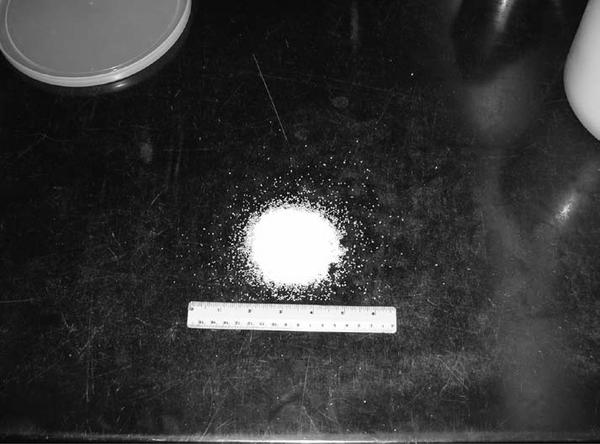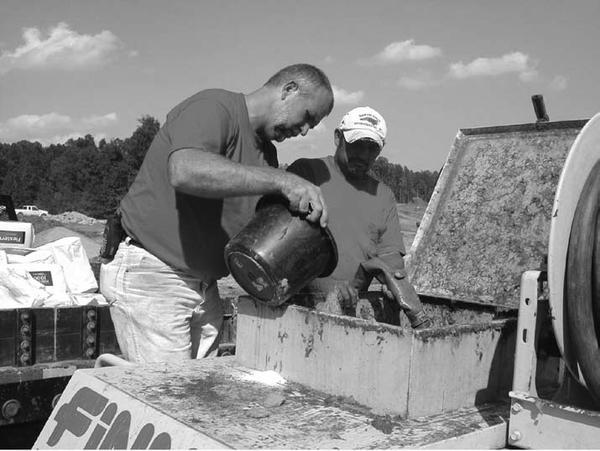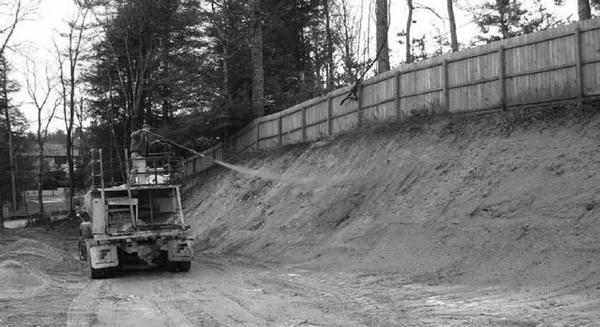Introduction
Sediment and turbidity have the widest impact on water quality of any pollutants. Runoff from sites where bare soil is exposed, such as construction sites or tilled farm fields, often carries high sediment loads into receiving water bodies where some of the sediment settles, filling channels and lakes and causing habitat destruction. One approach to reducing this type of erosion is to use chemical treatments to augment seeding and mulching. The chemical polyacrylamide (PAM) is well suited for erosion control enhancement, and its use is described below.
Characteristics of PAM
PAM is a term describing a wide variety of chemicals based on the acrylamide and acrylate units. When linked in long chains, these units can be modified to result in a net positive, neutral, or negative charge on the PAM molecule. The positively charged, or cationic, PAMs, are not used for erosion control because they can be toxic to fish and other aquatic organisms if they spill into water bodies in sufficient concentrations. The negatively charged, or anionic, PAMs, are much less toxic to aquatic organisms and are widely used in furrow irrigation agriculture. This type of PAM is the focus of this discussion, and all references to “PAM” are to the anionic forms.
PAM is available as a crystalline powder (Figure 1), an emulsion, or a solid block or “log.” It is nontoxic to humans and to other species in the environment. One of the ingredients used to make PAM is acryamide, which is a suspected carcinogen, and as a result the PAMs available for our uses are required to have less than 0.05 percent free acryamide. This quality control allows them to be used in food processing, drinking water treatment, and other uses where human exposure is likely.
PAM is water soluble, but dissolves very slowly and requires rapid agitation and extended mixing time. Water with more than 0.1 percent dissolved PAM is often noticeably viscous, and most PAMs have a maximum concentration of 0.5 to 1 percent in water. A good rule of thumb is to mix 1 pound of PAM per 100 gallons of water. When dry PAM becomes wet, it is very slippery and sticky and can create a slipping hazard.
Erosion Control
The erosion process is initiated when a rain droplet impacts the soil surface and dislodges soil particles. Once overland flow begins during a heavy or prolonged rain, these soil particles are then washed downslope. It has long been known that protecting the soil by maintaining plant cover or by mulching reduces potential erosion significantly. Therefore, erosion control should always begin with protecting the soil from rain droplets and slowing overland flow by using mulch and vegetation. PAM does not directly protect soil from rain droplet impacts, but it reduces soil detachment, maintains the soil’s structure, and increases infiltration rates early in the rain event.
PAM is applied as a liquid using typical erosion control equipment such as hydroseeders or hydromulchers. In the mixing tank, the powder is slowly introduced into the water under constant, heavy agitation (Figure 2). It is critical that it be introduced slowly to ensure that the granules do not stick together and form large globules, which are difficult to dissolve.
Once dissolved, usually after 30 minutes or more of agitating at least half a tank of clean water, the seed and mulch can be added, along with the rest of the water, as is typically done. An example of the calculations for a hydromulching application is given in Table 1. PAM is also reported to extend the achievable spray distance of the hydromulcher because of the added lubrication it provides. PAM can reduce the amount of water running off a site by increasing infiltration, at least initially. This effect is the result of maintaining soil structure, as opposed to improving it.
| Hydromulch Type | A. Typical Maximum Rate (lb/acre) | B. Typical Maximum Amount in Tank (lb/1,000 gal) | C. Liquid Applied Per Acre (gal) = (A/B)*1,000 |
D. PAM Added to Achieve 20 lb/acre (lb/1,000 gal) = (20 lc/C)*1,000 |
|---|---|---|---|---|
| Wood Fiber | 2,500 | 500 | 5,000 | 4 |
| Mechanically Bonded Fiber | 4,000 | 500 | 8,000 | 2.5 |
PAM also may reduce the turbidity of the runoff water beyond the reductions provided by the ground cover. In either case, the steeper the slope, the less benefit PAM will provide and the more critical it is that a good ground cover be used prevent erosion. Higher PAM rates will also be needed on steeper slopes (Figure 3). Dry granules have been applied directly with limited success, but dissolved PAM is more reliable because of better distribution and soil contact.
Overall considerations for using PAM to augment erosion control include:
- PAM should not be applied alone for erosion control, but in combination with mulch and seeding. This is especially important on steeper slopes.
- There are many types of PAMs, each with slightly different properties and ability to react with a specific soil. Be sure to use the PAM that works best on the soil at your site. Some suppliers and manufacturers will test your soil at no charge to determine the best PAM for your site.
- Seed germination and survival may be enhanced by PAM by increasing soil moisture through greater infiltration.
- PAM does not improve soil structure, but it will help maintain the existing structure for a period of time after application.
- Sandy soils with little clay will not benefit from PAM applications.
- Published research suggests that 20 pounds per acre are the minimum required for significant benefits in reducing erosion. At $6 per pound, this is an additional $120 per acre, which is a small fraction (less than 5 percent) of the usual hydromulching operation costs. The additional time for mixing will also need to be considered, however.
- Do not apply PAM to streams, lakes, or wetlands.
- When applying PAM to slopes immediately adjacent to bodies of water, be sure all runoff passes through a sediment control feature, such as a silt fence or check dam.
- Wet PAM is very slippery and therefore a hazard for slipping. Be sure to sweep up any dry PAM spilled onto surfaces used for walking or driving.
Additional Resources
Anionic Polyacrylamide Application. United States Department of Agriculture, Natural Resources Conservation Service (AL) Conservation Practice Standard 450. December 2012.
Sojka, R. E., R.D. Lentz. PAM Primer: A Brief History of PAM and PAM-related Issues.
Publication date: March 10, 2015
Reviewed/Revised: March 28, 2025
AG-439-61
N.C. Cooperative Extension prohibits discrimination and harassment regardless of age, color, disability, family and marital status, gender identity, national origin, political beliefs, race, religion, sex (including pregnancy), sexual orientation and veteran status.



